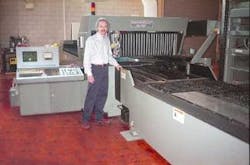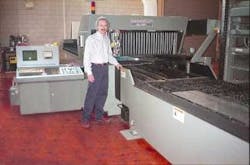Ten years to make a fast decision on laser cutting
After more than ten years of study, inMetal finally decided in 2000 to buy a laser cutting system for its 55-year-old fabrication business in Sharon, Mass. It's not that inMetal was slow, says Craig Perry, general manager, but that lasers were. "We had been looking at lasers on and off since the late 1980s, but did not see a productivity advantage for us," says Perry, an analytical type with a mechanical engineering degree from MIT and an MBA from the University of California-Berkeley. "Our products are hole-intensive and holes were relatively slow for a laser to do, compared to profiling cuts."
Even laser salespeople would reluctantly agree, after going through inMetal's 100-employee, 53,000-sq-ft. facility, that turret presses were the better choice for its specialization on intricate chassis, bases and other metal parts for Boston's electronics and high-tech industries.
Super-fast Cincinnati CL-707 laser cutting system was "a real blessing" for inMetal during recent downturn in technology business, says Craig Perry, general manager. Application versatility let inMetal run a wide range of materials and infinite shapes in mixed volumes and lots, keeping the laser the plant's busiest piece of equipment. "It covers a much broader range of material thickness," says Perry. "On the light end we can run the laser competitively on any volumes and on the heavy end we can only run the laser." Ability to cut thicker materials without tooling costs or problems helped inMetal grow that end of the business, particularly in stainless-steel structures.
However, when conditions and technology finally looked right, the family owned business moved aggressively. Deciding on its first laser, inMetal "jumped in" at the top-end in machine speed and accuracy with a Cincinnati CL-707 laser cutting system featuring breakthrough linear motor drive technology. Not stopping there, it also ordered a new-to-market automated load/unload system to maximize the laser's throughput.
What changed inMetal's mind on lasers, Perry says, were laser technology developments and shifts in customer requirements. "For a long time, we tended to make smaller things and customers did their own assembly. In recent years, we've attracted more complex work, larger parts and more assembly business—both mechanical and electro-mechanical." The assembly business has grown in complexity as well as volume. Where inMetal once did typical assemblies of five or fewer parts, some assemblies today involve more than 200 components, putting greater premium on processing flexibility.
Over the 1990s the company also built a growing niche at precision fabrication of heavier materials and frames for electronics and high-tech customers. "Most heavy fab shops can't handle the tolerances or the level of quality demanded by the electronics industry," says Perry.
Capabilities at heavier materials also allowed inMetal to broaden its customer base, particularly with stainless-steel structures for the food industry, Perry adds. However, the company's turret presses had problems processing the thicker materials. "We ran up to 1/4 in., but it's a fairly slow process," says Perry. "Heavy stock, especially stainless, eats up tooling—knocks the edges off the punches and galls like crazy. For a couple years before we bought the laser, we were sending out some work to a subcontractor to have it laser cut."
InMetal finally decided it had sufficient volume of business and mix of materials to justify its own laser. "By that time, the industry had increased laser cutting and piercing speeds dramatically," says Perry. "Here was laser technology that could reasonably compete with a turret press, we felt, and be cost-effective even for our fairly hole-intensive parts."
The fabricator selected Cincinnati's super-fast CL-707 laser cutting system, the first domestic laser system to feature linear motor drive and a direct-drive system that provides exceptional stiffness to enable superior processing speed and part accuracies. The motion system delivers acceleration exceeding 2.0 G and positions the laser at speeds up to 10,000 inches per minute, with 0.000006-in. resolution. Advanced CNC achieves positioning accuracy of ±0.001 in. per axis and repeatability of 0.0002 in. per axis.
As it turned out, inMetal bought the laser for growth, but just about the time it was installed, the economy went into a slowdown, hitting the high-tech segment particularly hard. "Our high-tech business slowed dramatically, dropped about 40 percent if you go by our turret press utilization," Perry says. "The one busy piece of equipment in our shop was the laser. It's been a real blessing. We've been able to bring in a lot of heavier work—3/16-in. and 1/4-in. steel and stainless—that we can't process efficiently on a turret press, as well as a fair amount of 5/16-in. and 3/8-in. material that simply can't be run on our turrets. Once you get above 10 gage, you want to go to the laser so you don't destroy your tooling or get into plug-pulling problems."
The company is also using the laser for aluminum parts that require contouring. "Anything with contouring, it can do competitively," Perry says. Except on work that is hole intensive or requires forming, there is probably no part quantity where the laser can't be competitive, he feels. "On the light end, you can run the laser competitively on any volumes, and on the heavy end, you only have the laser. Even on hole-intensive work, the laser is competitive up to about 150 or 250 parts."
Unlike shears and turret presses, which are most efficient producing multiple quantities of the same part, the laser allows production of many different parts and shapes at the same time, without tooling or setup requirements, so long as they share the same metal specification. This fits well with inMetal's highly variable mix of business.
To optimize processing flexibility and productivity, inMetal bought Cincinnati's Automatic Load and Unload System, which moves sheet material from any of eight different shelves to the open pallet of the laser's dual-pallet system. After pallet change, it unloads the alternate pallet of finished parts and reloads it with appropriate material for the next run.
The automated system offers two key advantages for inMetal's mix of business: multi-shelf capability for quick-change processing and automated load and unload to maximize productivity and throughput on long runs. Both are important considerations with heavier materials that can put a lot of physical strain on operators.
This combination of features makes the laser ideal for serving some of inMetal's best customers. Perry notes, "We have programs where we'll make thousands of parts over a couple of weeks, but customers also know they can come to us for anything from one part to 25 or 30. We can meet their total needs—volume work, prototyping and development work, custom designs and special projects."
Put all those factors together, and, Perry admits, "It's a scheduling nightmare—trying to balance production over the whole shop. But the laser lets us better handle the mix while keeping operator and machine productivity high."
Richard Neff is manager of laser products at Cincinnati Inc. (Cincinnati, OH). For more information call (513) 367-7165, Fax (513) 367-7592 or e-mail [email protected].

